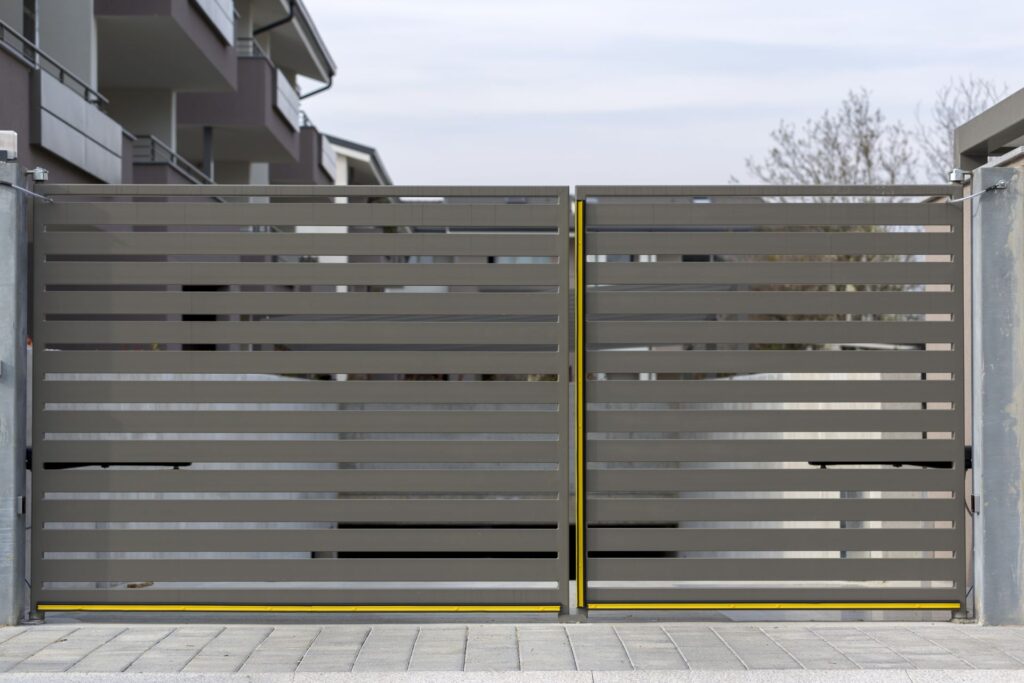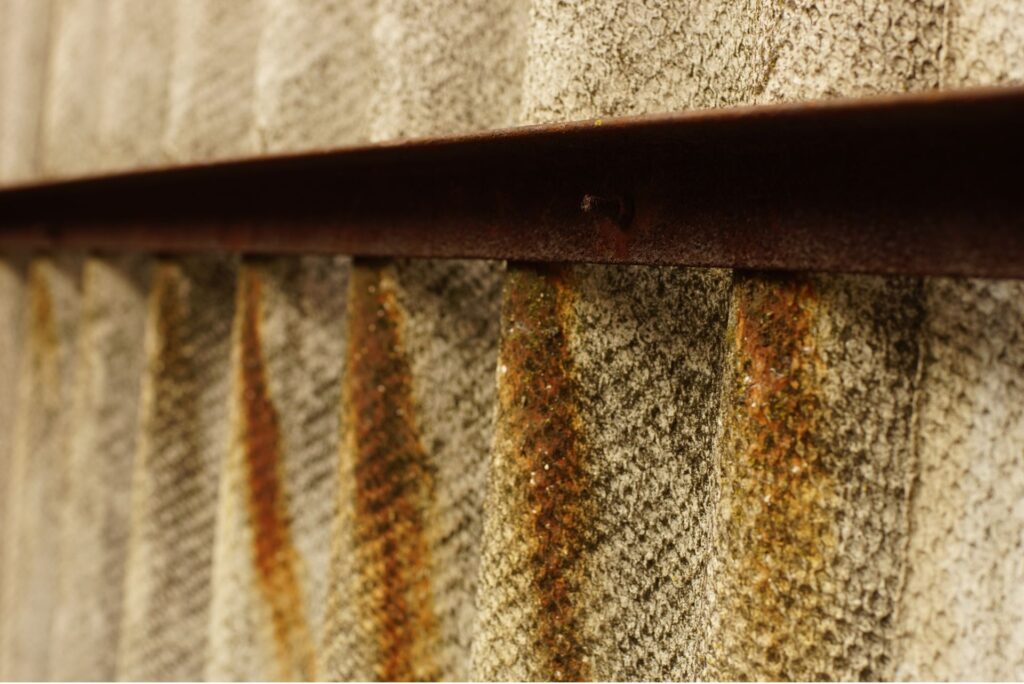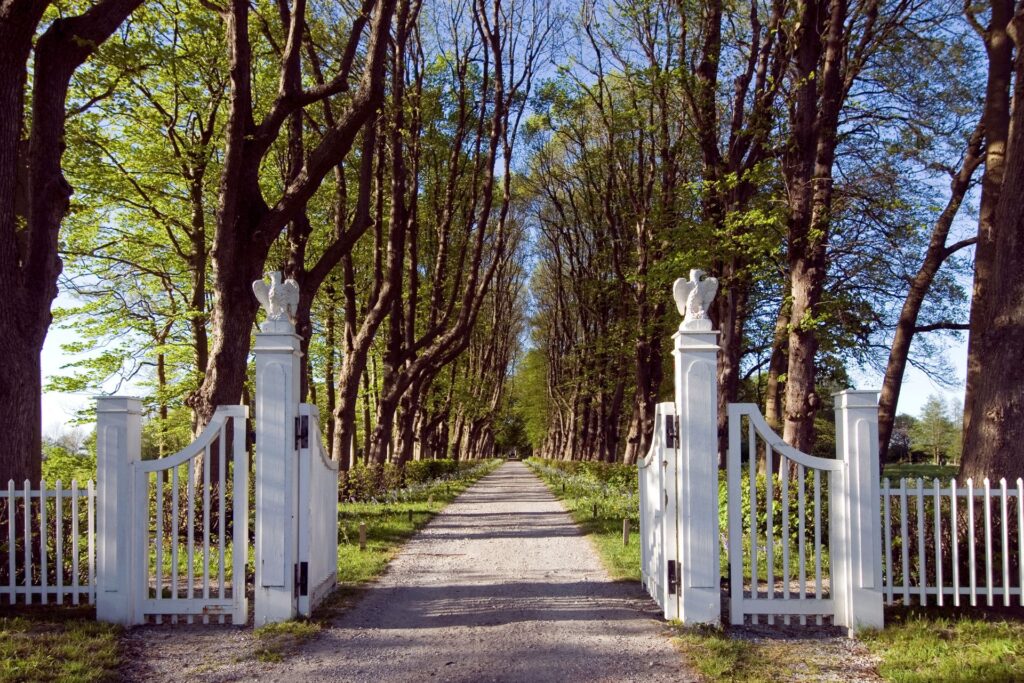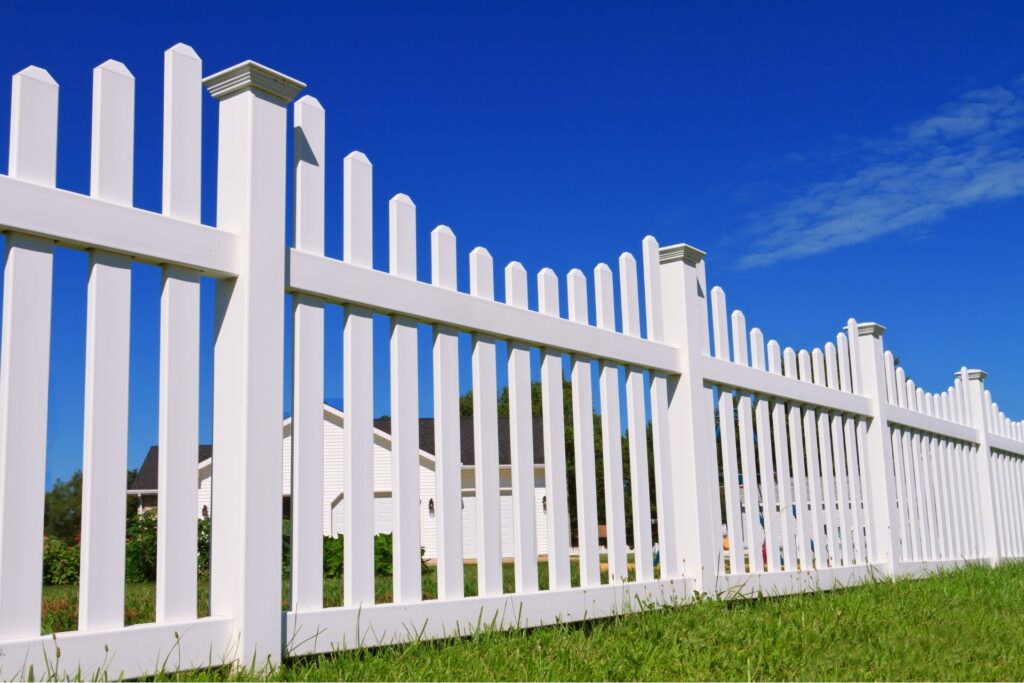Welcome to the ultimate guide on deciding how many gates your fence should have, tailored specifically for homeowners in New Zealand. This isn’t just about drawing lines and marking territories; it’s about creating a welcoming entrance to your space, ensuring privacy, and enhancing security, all while adding to the aesthetic appeal of your home. Gates play a crucial role in this—serving not only as points of entry and exit but also as key features that reflect your home’s character and style. Through this guide, we aim to navigate you through the myriad of considerations, helping you make informed decisions that align with your property’s layout, your personal needs, and, importantly, New Zealand’s unique local regulations. So, let’s open the gate to a journey that ensures your fencing decisions are as informed and personalized as possible.
In New Zealand, determining the ideal number of gates for a fence depends on several factors: the size and layout of your property, the fence’s purpose (such as privacy, security, or decoration), and local council regulations. Generally, urban residential properties benefit from at least one front gate and possibly a side or rear gate for access and convenience. Larger rural properties may require multiple gates for different purposes, including vehicle access, livestock movement, and pedestrian entry. Always consult with your local council to ensure compliance with any specific requirements or restrictions.
Table of Contents
Understanding The Basics Of Fence Gates
In the realm of residential fencing, the gate holds a pivotal role, seamlessly blending functionality with aesthetics to enhance the overall appeal and security of your home. This article delves into the basics of fence gates, aiming to provide homeowners and enthusiasts with a comprehensive understanding of what a gate is, its primary functions, and the common types you might encounter, particularly in New Zealand.
What Constitutes a Gate?
A gate, in the context of residential fencing, is more than just a point of entry or exit. It’s a movable barrier that integrates into the fence line, designed to provide controlled access to a property. Gates can vary widely in design, size, and material, reflecting the homeowner’s style and the property’s architectural characteristics. Whether it’s a simple wooden gate in a picket fence or a grand wrought iron gate leading to a sprawling estate, each serves as a transitional point that symbolizes the threshold between the public outer world and the sanctity of one’s private space.
The Primary Functions of Gates
Gates serve three fundamental purposes: accessibility, security, and aesthetics. Let’s explore each of these in more detail:
Accessibility: At its core, a gate provides a point of access to and from a property. It ensures that movement in and out is convenient for residents while controlling access for visitors. This function is crucial for day-to-day operations of a home, from welcoming guests to receiving deliveries.
Security: A gate is a critical component of a home’s security system. It acts as a physical barrier, deterring unauthorized entry and enhancing the safety of those within. The level of security can vary based on the design and features of the gate, such as the incorporation of locks, security cameras, or intercom systems.
Aesthetics: Gates significantly contribute to the curb appeal of a property. They offer an opportunity to make a statement, complement the home’s architectural style, or express the homeowner’s personal taste. A well-designed gate can enhance the visual appeal of a property, adding to its value and charm.
Types of Gates Commonly Used in New Zealand
In New Zealand, homeowners favor a variety of gates, each suited to different needs and property layouts. The most commonly used types include:
Swinging Gates: These are traditional gates that open inward or outward from a hinge point. They can be single or double, depending on the size of the entrance and are popular for their simplicity and ease of use.
Sliding Gates: Ideal for properties with limited space or sloping driveways, sliding gates move horizontally along a track. They are efficient space savers and can be manually or automatically operated.
Automated Gates: Technology has paved the way for automated gates, which can be opened and closed with the push of a button. This type offers enhanced security and convenience, allowing homeowners to control access remotely.
Understanding the basics of fence gates is crucial for anyone looking to enhance their property’s functionality, security, and aesthetic appeal. By considering the different types and functions of gates, homeowners can make informed decisions that best suit their needs and reflect their personal style. Whether you’re in New Zealand or elsewhere, the right gate can make a significant difference in the enjoyment and security of your home.
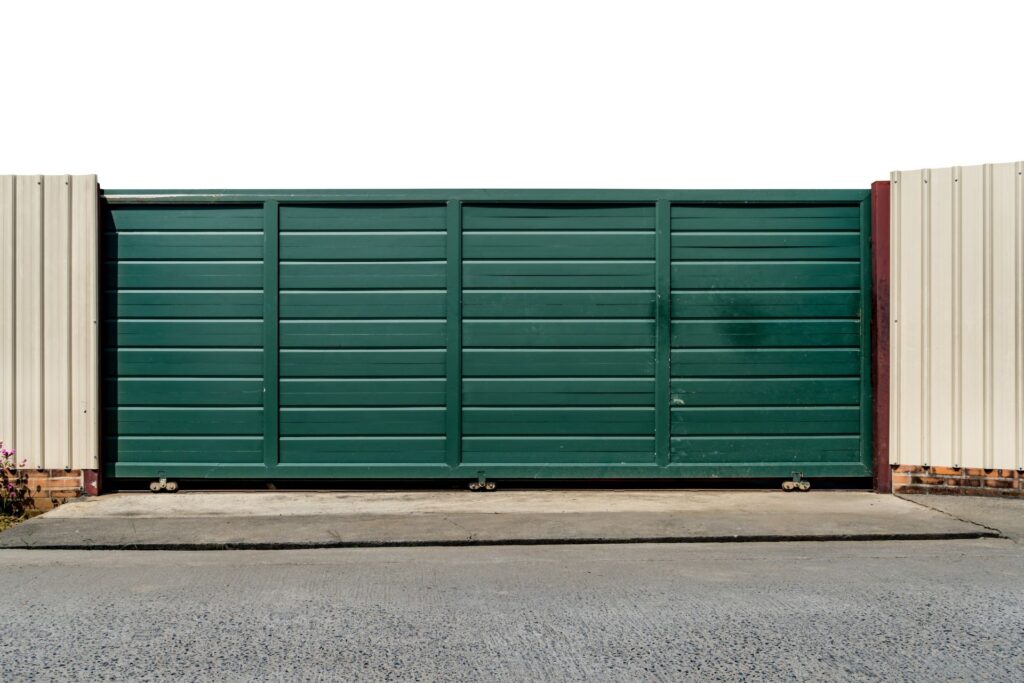
Factors Influencing The Number Of Gates
When considering the design and functionality of fencing for your property, one key aspect to think about is the number of gates you’ll need. This decision isn’t one-size-fits-all; it significantly depends on various factors, such as the size and layout of your property, the primary purpose of the fence, and local regulations, especially in places like New Zealand. Let’s delve into these aspects to provide a comprehensive understanding that caters to homeowners and property developers alike, ensuring the information is engaging and valuable for SEO purposes without appearing as AI-generated content.
Property Size and Layout
The size and layout of your property are paramount in determining the optimal number of gates. A larger property may require multiple access points for convenience, ensuring that you can enter and exit the property from different locations. This is particularly relevant for properties that span over large areas or have multiple buildings that require easy access.
Moreover, the layout of the property, including the positioning of driveways, pathways, and landscaping features, plays a crucial role. A well-thought-out gate placement can enhance the functionality of your space, providing direct access to areas that are frequently used. For example, a gate leading directly to a backyard garden or a detached garage can significantly improve the flow and accessibility of your property.
Purpose of the Fence
The intended purpose of your fence greatly influences the number of gates you might need. Fences erected for security purposes, for instance, may require fewer gates to minimize potential entry points for unauthorized access. On the other hand, a fence intended for privacy might still need multiple gates to maintain accessibility without compromising the secluded feel of your space.
If the primary goal is to contain pets within your property, gates must be strategically placed to allow easy entry and exit while ensuring pets cannot escape. Decorative fences, which aim to enhance the aesthetic appeal of the property, offer more flexibility in gate placement and number, allowing homeowners to balance functionality with design.
Local Regulations and Permissions in New Zealand
In New Zealand, local regulations and permissions can significantly influence gate placement and the number of gates on a property. It’s crucial to be aware of and comply with the specific requirements set by your local council. These regulations may pertain to the height of the fence, the materials used, and the proximity to public pathways or neighboring properties.
Before making any decisions or commencing construction, it’s essential to check with your local council to understand the guidelines that apply to your area. This step ensures that your fencing project aligns with local standards and avoids potential legal issues or the need for modifications down the line.

Recommended Number Of Gates For Different Types Of Properties
When it comes to enhancing the functionality and security of a property, the importance of gate installation cannot be overstated. Gates not only serve as critical access control points but also contribute to the aesthetic appeal of a property. Whether it’s a cozy urban residence, a sprawling rural estate, or a bustling commercial facility, the choice and number of gates play a pivotal role in meeting the specific needs of each property type. In this article, we delve into the recommended number of gates for different types of properties, providing valuable insights to homeowners, property managers, and developers alike.
Urban Residential Properties
Urban residential properties, typically characterized by their compact sizes and close proximity to neighbors, require thoughtful consideration regarding gate installation. For small to medium-sized urban homes, a single main entrance gate often suffices. This gate primarily serves as the point of entry and exit for both residents and visitors, ensuring security and privacy. It’s advisable to opt for a gate design that complements the architectural style of the home while offering robust security features. In neighborhoods where space allows, a pedestrian gate can be added alongside the main gate. This not only enhances convenience but also minimizes the wear and tear on the larger gate due to frequent opening and closing.
Rural or Large Properties
Rural or large properties, with their expansive boundaries and diverse functionalities, typically necessitate multiple gates. The primary gate serves as the main access point, often located at the property’s front, welcoming guests and granting entrance to the main residence. Secondary gates are crucial for providing access to different areas of the property, such as agricultural fields, barns, or service entrances. For properties with livestock, specialized gates are required to facilitate the movement of animals while ensuring their safety. Moreover, emergency access gates may be considered essential for providing an alternate exit in case of emergencies, thereby enhancing the overall safety and accessibility of the property.
Commercial Properties
While the focus of our discussion is mainly on residential properties, it’s worth briefly touching upon the gate needs of commercial properties. Commercial facilities, depending on their size and nature of business, may require multiple gates for efficient access control, delivery of goods, and emergency egress. Security becomes a paramount concern, necessitating the installation of gates equipped with advanced access control systems.
Determining the ideal number of gates for a property involves a thorough assessment of the property’s size, layout, and specific needs. For urban residential properties, simplicity and security can often be achieved with a single main gate, possibly complemented by a pedestrian gate. In contrast, rural or large properties demand a more strategic approach, with multiple gates catering to varied access needs. Commercial properties, while not the main focus here, also benefit from tailored gate solutions to meet their unique operational requirements.
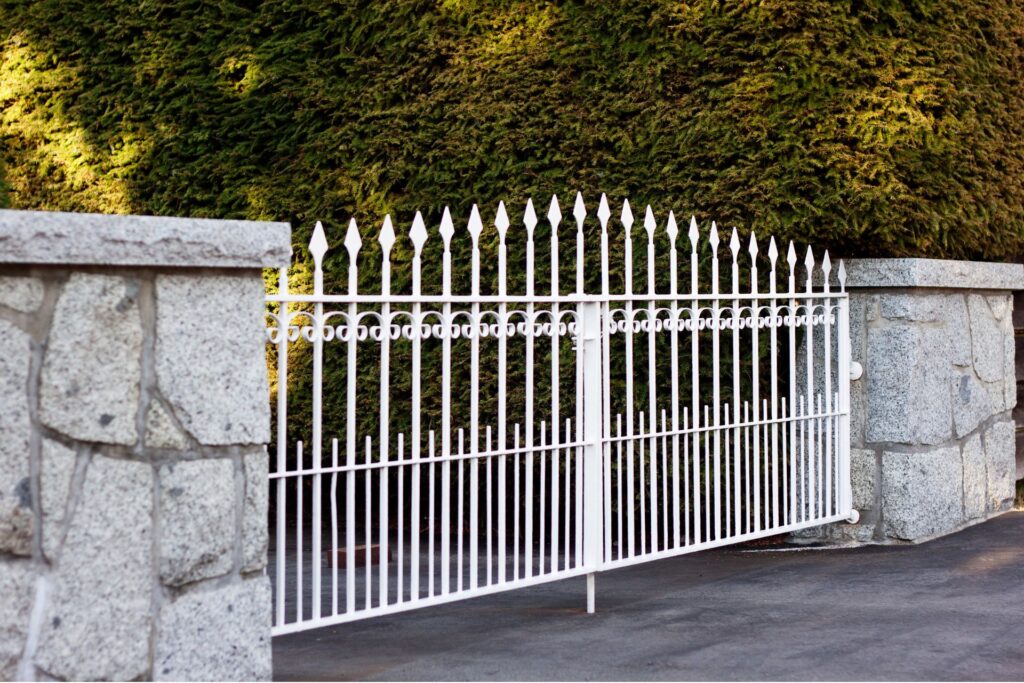
Design And Placement Tips For Fence Gates
When it comes to enhancing the curb appeal and functionality of your property, the right fence gate can make a significant difference. It’s not just about choosing a gate but selecting one that complements your fence, fits your property’s layout, and meets your security needs. Let’s dive into some essential design and placement tips for fence gates to help you make informed decisions.
Aesthetics and Design Harmony
The gate is often the first point of contact for anyone visiting your property, making its design and harmony with the surrounding fence crucial. Here are tips to ensure your gate enhances your property’s aesthetic appeal:
Match Your Architectural Style: Your gate should echo the architectural style of your home. A modern, minimalist home might suit a sleek, metal gate, while a rustic or country-style home might call for a wooden gate that highlights natural beauty.
Complementary Materials and Colors: Choose materials and colors that complement not only the fence but also the exterior of your home. Consistency in material and color creates a cohesive look, enhancing the overall appeal of your property.
Detailing and Decor: Incorporate details that tie your gate’s design back to your home, whether through ironwork patterns that mirror elements of your home’s architecture or through the use of similar lighting fixtures.
Practical Placement
The placement of your gate plays a pivotal role in the functionality of your entrance. Here are some considerations for practical gate placement:
Natural Pathways: Place your gate along natural access routes to your property. Consider the paths people are most likely to take from the street to your front door and position your gate accordingly.
Accessibility: Ensure your gate is easily accessible for both pedestrians and vehicles. If your property has a driveway, the gate should accommodate the turning radius of vehicles and provide ample space for entry and exit.
Visibility: Place your gate in a location where it is easily visible from the house. This not only adds to the aesthetic appeal but also enhances security by allowing you to monitor who approaches your property.
Security Considerations
While aesthetics and placement are important, security is a paramount concern. Here’s how gate design and placement can affect your property’s security:
Height and Opacity: A taller gate provides more privacy and security, deterring unauthorized access. However, ensure it doesn’t compromise the aesthetic appeal or make your property feel fortress-like. Consider designs that offer a balance between openness and security.
Locks and Access Control: Invest in high-quality locks and consider smart access control systems that allow you to remotely control and monitor gate access. These systems can offer both convenience and enhanced security.
Strategic Placement: Avoid placing your gate in secluded areas where intruders could attempt access unnoticed. Strategic placement in well-lit, visible areas can deter potential intruders.
In conclusion, the right design and placement of your fence gate are crucial for enhancing both the aesthetic appeal and functionality of your property. By considering these tips, you can choose a gate that complements your home’s architecture, offers practical access, and boosts your property’s security. Remember, a well-thought-out gate not only adds value to your property but also makes a statement about your attention to detail and care for your home’s overall appearance.
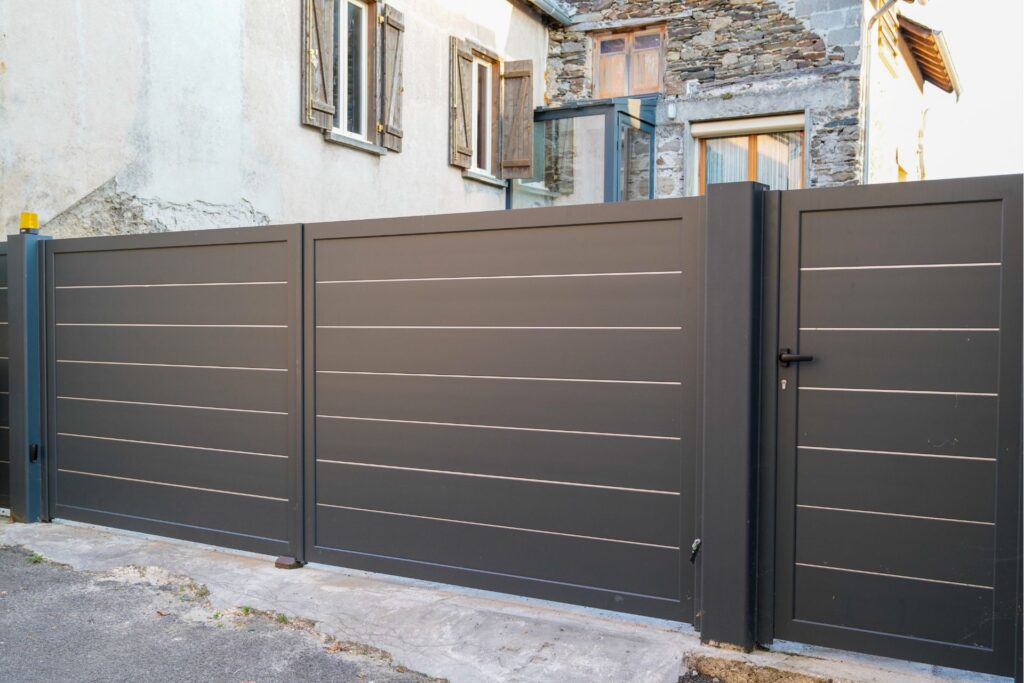
Installing Gates: DIY VS. Professional Installation
When it comes to enhancing your home’s security and aesthetic appeal, installing a gate is a popular option. But should you dive into a do-it-yourself (DIY) project, or is it wiser to hire a professional? Understanding the pros and cons of each approach can help you make an informed decision that suits your needs, budget, and skill level.
DIY Considerations for Gate Installation
Embarking on a DIY gate installation can be an exciting project for the hands-on homeowner. It offers a sense of accomplishment and the opportunity to tailor the project to your exact specifications. Here’s what to consider if you’re thinking of installing a gate yourself:
Preparation is Key: Start by researching the type of gate that best suits your property. Consider materials, styles, and functionality. You’ll also need to measure your space accurately to ensure your gate fits perfectly.
Basic Steps: The process generally involves setting posts, installing the gate, and ensuring it swings or slides correctly. It might also include installing hardware and automated opening systems if required.
Tools and Materials: Ensure you have all the necessary tools and materials before you begin. This may include concrete, posts, hinges, screws, and the gate itself, along with any specialized tools for cutting or welding, depending on your gate’s material.
Skill Level: Assess your skills honestly. Basic carpentry and handyman skills are often sufficient for simple gate installations, but more complex setups might require advanced skills.
Time and Cost: DIY can be more cost-effective, but remember to factor in the value of your time and any potential redo’s if mistakes are made.
When to Hire a Professional for Gate Installation
While DIY projects have their appeal, hiring a professional can offer peace of mind and several key benefits, especially for more complex installations:
Quality and Expertise: Professionals bring years of experience, ensuring high-quality work that stands the test of time. They can handle a wide range of materials and styles, delivering a finished product that aligns with your vision and safety standards.
Warranty and Support: Many professional installations come with a warranty, both on the materials and the labor. This means you’re covered if anything goes wrong post-installation.
Dealing with Challenges: Professionals are equipped to handle unforeseen issues such as uneven terrain, complex integration with home security systems, or compliance with local building codes.
Time Efficiency: A professional team can complete the installation faster than a DIY approach, minimizing disruption to your daily life and getting your gate up and running promptly.
Cost Consideration: While hiring a professional can be more expensive upfront, it might save you money in the long run by avoiding costly mistakes and ensuring a durable installation.
Making Your Decision
Whether to install a gate yourself or hire a professional depends on several factors, including your skill level, the complexity of the project, and your budget. DIY projects can be rewarding and cost-effective for simpler installations. However, for more complex gates or if you’re seeking guaranteed quality and durability, professional installation is the way to go.
Remember, the right decision is the one that best meets your needs and ensures that your gate serves its purpose effectively, enhancing the security and beauty of your home for years to come.

Maintenance Tips For Fence Gates
When it comes to ensuring the longevity and durability of fence gates, particularly in New Zealand where diverse weather conditions can take their toll, adhering to a set of simple, routine maintenance tips is crucial. This guide aims to provide homeowners with practical advice on how to care for their gates, focusing on the most common gate materials found in the country: wood, metal, and vinyl. By incorporating these maintenance strategies into your regular home care routine, you can significantly extend the life of your fence gates, maintaining their functionality and aesthetic appeal for years to come.
Wooden Gate Maintenance
Wooden gates are a popular choice in New Zealand for their natural beauty and versatility. However, they require regular maintenance to prevent rot, warping, and damage from pests:
Inspect and Clean Regularly: Check your wooden gate every few months for signs of damage or wear. Use a soft brush and mild soap solution to gently clean the surface, removing dirt, debris, and any mildew.
Seal and Protect: Apply a high-quality wood sealant every two to three years to protect against moisture, which can lead to rot and decay. Choose a sealant that offers UV protection to prevent fading caused by the sun.
Check for Pests: Regularly inspect your gate for signs of termite damage or other pest infestations. Early detection is key to preventing serious damage.
Metal Gate Maintenance
Metal gates, including those made from steel or aluminum, are known for their strength and security. However, they can be prone to rust and corrosion:
Rust Prevention and Treatment: Inspect your gate regularly for rust spots. If you find any, sand the area down to the metal and apply a rust-inhibiting primer followed by paint. For aluminum gates, use a specialized cleaner to remove any oxidation.
Lubricate Moving Parts: Keep hinges and locks lubricated with a suitable metal lubricant. This prevents squeaking and ensures smooth operation.
Clean Regularly: Use a mild soap solution and water to clean your metal gate, removing dirt and grime that can accumulate and lead to corrosion over time.
Vinyl Gate Maintenance
Vinyl gates are chosen for their low maintenance and resistance to weathering. However, they still require some care to keep them looking their best:
Cleaning: Vinyl gates can be easily cleaned with a hose and a soft cloth or sponge. For tougher stains, a mild detergent solution can be used. Avoid abrasive cleaners that can scratch the surface.
Check Hardware: Even though vinyl is low maintenance, the hardware on your gate can loosen over time. Periodically check and tighten any screws or hinges.
Avoid Heavy Loads: To prevent sagging or warping, avoid placing heavy objects on or against your vinyl gate.
By following these maintenance tips, you can ensure that your fence gate, whether wood, metal, or vinyl, remains a functional and attractive feature of your property for many years. Regular care not only extends the life of your gate but also enhances the overall curb appeal of your home. Remember, a little effort goes a long way in preserving the beauty and integrity of your fence gates.
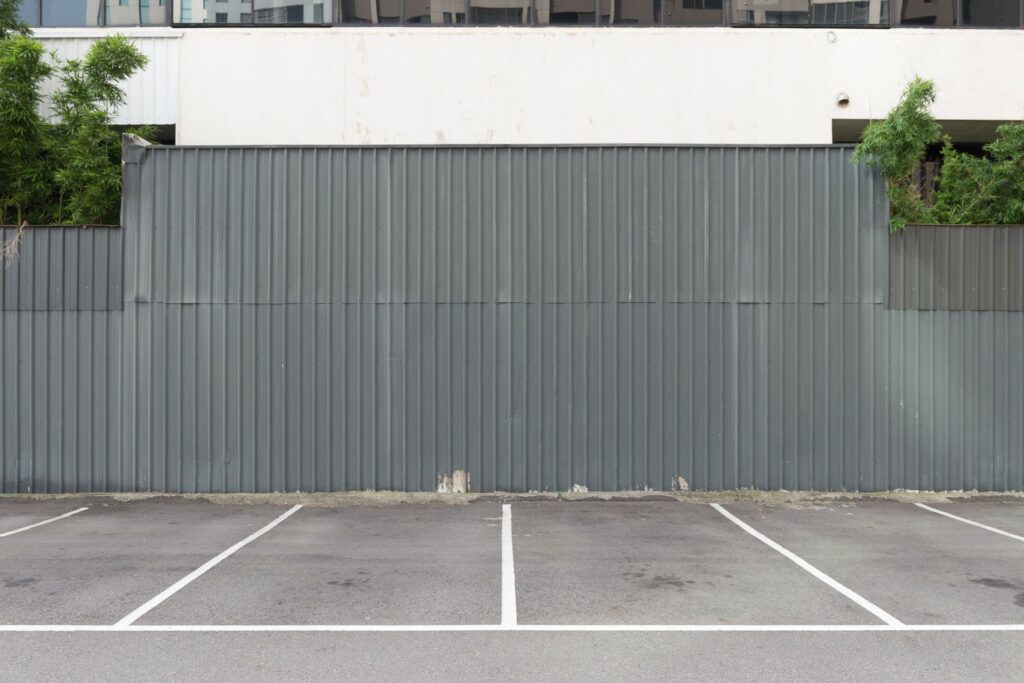
Common Mistakes To Avoid
Creating a harmonious and functional home environment extends beyond the interior decor to include the practical aspects of property layout and security. Among these, the decision on the number of gates for your property is pivotal. It’s not merely an aesthetic choice but one that impacts convenience, security, and privacy. Today, we’ll dive into some common mistakes homeowners often make when deciding on the number of gates for their homes and share insights on how to sidestep these pitfalls.
Overlooking Future Needs
One prevalent mistake is not considering future needs. Homeowners might opt for a single gate, finding it sufficient for their current lifestyle. However, as families grow and need change, this decision might not serve well in the long run.
Tip: When planning your gates, think about potential future scenarios, such as acquiring a larger vehicle, needing separate access for garden maintenance, or wanting a dedicated entrance for guests. Planning with foresight can save you from inconvenient and costly modifications down the line.
Ignoring Property Layout and Access Points
Another oversight is neglecting the property’s layout and natural access points. Sometimes, homeowners choose gate locations based on current trends or aesthetic preferences without considering the practicality of everyday use.
Tip: Evaluate your property’s layout thoroughly. Consider factors like the driveway’s length, the position of pedestrian walkways, and how your gates can complement the natural flow of movement into and out of your property.
Underestimating the Value of Privacy and Security
A common pitfall is underestimating how gate placement and the number of gates can affect privacy and security. A single, main entrance gate might seem sufficient, but it could also be a vulnerability.
Advice: Assess your property’s exposure. In some cases, additional gates can enhance privacy and security by providing controlled access to different areas of your property.
Choosing Gates Solely Based on Design
While the aesthetic appeal of gates cannot be understated, selecting gates solely based on design without considering functionality is a mistake. Gates that look stunning but don’t meet your privacy or security needs, or that are impractical for daily use, can become a source of frustration.
Recommendation: Balance aesthetics with functionality. Ensure the design you choose complements your home’s style while fulfilling your practical needs for access, privacy, and security.
Deciding on the number of gates for your property is a decision that warrants careful consideration. By avoiding the common mistakes of overlooking future needs, ignoring property layout, underestimating privacy and security, and choosing gates solely for their design, you can make a choice that enhances both the functionality and aesthetic appeal of your home. Remember, the right decision now can contribute to a more secure, accessible, and beautiful home environment for years to come.

FAQs: About Fence Gates In New Zealand
How do I decide the number of gates needed for my property?
The number of gates you need depends on your property’s size and layout, the primary purpose of your fence (security, privacy, pet containment, etc.), and local council regulations. Consider how you and others will use the space and the convenience of accessing different parts of your property.
What are the most common types of gates used in New Zealand homes?
New Zealanders commonly use swinging gates for pedestrian access, sliding gates for properties with limited space, and automated gates for convenience and security. The choice often depends on personal preference, space availability, and budget.
Are there specific local regulations in NZ I need to be aware of when installing a fence gate?
Yes, local regulations can vary significantly across New Zealand. It’s essential to check with your local council for any specific requirements or restrictions regarding fence and gate height, design, and placement before installation.
Can I install a fence gate myself, or should I hire a professional?
While DIY gate installation is possible and can be a rewarding project, it requires the right tools, skills, and understanding of the installation process. For complex installations (like automated gates) or if you’re unsure about the process, hiring a professional is recommended.
How often should I maintain my fence gate?
Regular maintenance is crucial to ensure your gate functions well and lasts longer. Check and maintain your gate at least once a year, including cleaning, checking for rust or damage, lubricating moving parts, and making any necessary repairs.
What materials are best for fence gates in NZ’s climate?
Materials such as treated wood, aluminum, and galvanized steel are popular choices for New Zealand’s varied climate. These materials offer durability against the elements, from coastal salt spray to UV exposure and rain.
What are some common mistakes to avoid when choosing a fence gate?
Common mistakes include not considering the gate’s placement and size carefully, overlooking local regulations, choosing materials unsuited to the local climate, and underestimating the importance of maintenance.
How can I ensure my fence gate enhances my property’s security?
Choose a gate design that is difficult to climb over or breakthrough, ensure it is well-lit and visible from the house, and consider installing locks or an intercom system for added security.
Can the number of gates affect my property’s value?
Yes, well-designed and appropriately placed gates can enhance your property’s curb appeal and security, potentially increasing its value. However, too many gates or poorly placed gates might have the opposite effect.
Where can I find more information about fencing and gate installation in New Zealand?
For more detailed information, consult with local fencing professionals, visit home improvement stores, or check the website of your local council for guidelines and regulations regarding fencing and gate installation in your area.
Conclusion
Selecting the ideal number of gates for your fence in New Zealand is a crucial aspect of your fencing project, impacting accessibility, security, and compliance with local regulations. It’s essential to balance your specific needs and property layout with the functional and aesthetic goals of your fencing. Consider how gates will facilitate movement, enhance security, and integrate with the overall design of your property. Given New Zealand’s diverse landscapes, from urban to rural, the importance of gate placement cannot be overstated for both convenience and safety.
Consulting with a professional fencing expert is highly recommended to navigate these considerations effectively. They can provide tailored advice, ensuring your fence not only meets your expectations but also adheres to local standards, ultimately enhancing the functionality and appeal of your property. Remember, the thoughtful integration of gates can significantly influence the daily enjoyment and practicality of your space.
